Related Research Articles

Googie architecture is a type of futurist architecture influenced by car culture, jets, the Space Age, and the Atomic Age. It originated in Southern California with the Streamline Moderne architecture of the 1930s, and was popular nationwide from roughly 1945 to the early 1970s.

Arthur Brown Jr. (1874–1957) was an American architect, based in San Francisco and designer of many of its landmarks. He is known for his work with John Bakewell Jr. as Bakewell and Brown, along with later works after the partnership dissolved in 1927.
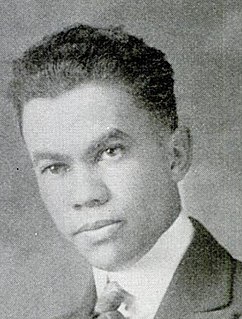
Paul Revere Williams, FAIA was an American architect based in Los Angeles, California. He practiced mostly in Southern California and designed the homes of numerous celebrities, including Frank Sinatra, Lucille Ball and Desi Arnaz, Lon Chaney, Barbara Stanwyck and Charles Correll. He also designed many public and private buildings.

Streamline Moderne is an international style of Art Deco architecture and design that emerged in the 1930s. It was inspired by aerodynamic design. Streamline architecture emphasized curving forms, long horizontal lines, and sometimes nautical elements. In industrial design, it was used in railroad locomotives, telephones, toasters, buses, appliances, and other devices to give the impression of sleekness and modernity.

Downtown Long Beach is the heart of Long Beach, California, United States, and is the location for most of the city's major tourist attractions and municipal services. It is also the location for numerous businesses. There are many hotels and restaurants in the area that serve locals, tourists, and convention visitors.
Claud W. Beelman, sometimes known as Claude Beelman, was an American architect who designed many examples of Beaux-Arts, Art Deco, and Streamline Moderne style buildings. Many of his buildings are listed on the National Register of Historic Places.
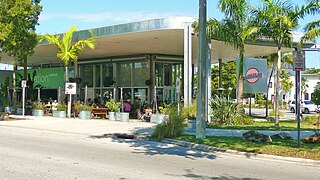
The Upper Eastside is a neighborhood in Miami, Florida, United States. It is north of Edgewater, east of Little Haiti, south of the village of Miami Shores, and sits on Biscayne Bay. In geographical order from south to north and east to west, it contains the subdivisions of Magnolia Park, Bay Point, Morningside, Bayside, Belle Meade, Shorecrest, and Palm Grove. The MiMo District along Biscayne Boulevard in the area is host to many art galleries, shops and restaurants.

The Erie Federal Courthouse and Post Office, also known as Erie Federal Courthouse, in Erie, Pennsylvania, is a complex of buildings that serve as a courthouse of the United States District Court for the Western District of Pennsylvania, and house other federal functions. The main courthouse building was built in 1937 in Moderne architecture style. It served historically as a courthouse, as a post office, and as a government office building. It was listed on the National Register of Historic Places in 1993. By the late 1980s, the federal courts needed more space to effectively serve the public. To resolve the space shortage, the General Services Administration undertook a bold plan to purchase, restore, and adaptively use two adjacent historic buildings: the Main Library and the Isaac Baker & Son Clothing Store. The existing courthouse was rehabilitated and two additions were constructed. Each of the buildings in the complex is of a different architectural style.
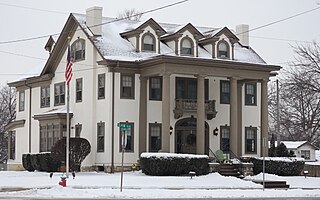
The H.W. Gates Funeral Home is a historical landmark at 1901 Olathe Blvd in Kansas City, Kansas. Designed by Architect Fred S. Wilson in 1922, it served as the Gates family residence as well as their place of business. The 2+1⁄2-story building was built in the Neoclassical style.

The Superintendent's Residence at the Utah State Hospital is a historic house located at the Utah State Hospital in east Provo, Utah, United States. It was listed on the National Register of Historic Places in 1986.

The Petaluma Historic Commercial District is a 17.4 acres (7.0 ha) historic district in Petaluma, California which was listed on the National Register of Historic Places in 1995. It is located along Petaluma Boulevard, between B St. and Prospect St.
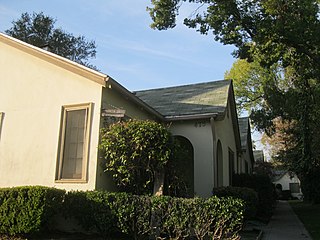
Washington Court is a bungalow court located at 475 E. Washington Blvd. in Pasadena, California. The court consists of six single-family homes arranged in an "L" shape; a common walkway and garden runs along the east side of the court, while a driveway on the west side accesses a rear garage. The homes are designed in the English Cottage Revival style and feature cross gabled roofs with wooden louvers at the gable ends, wooden trim and window moldings, and arched entrances with flared eaves. F. R. Finch commissioned the court in 1924; the homes cost $2,250 each to build.

PWA Moderne is an architectural style of many buildings in the United States completed between 1933 and 1944, during and shortly after the Great Depression as part of relief projects sponsored by the Public Works Administration (PWA) and the Works Progress Administration (WPA).
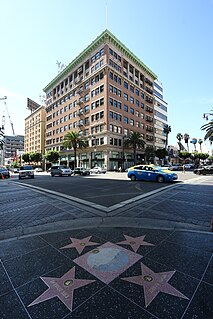
The Broadway Hollywood Building is a building in Los Angeles' Hollywood district. The building is situated in the Hollywood Walk of Fame monument area on the southwest corner of the intersection referred to as Hollywood and Vine, marking the intersection of Hollywood Boulevard and Vine Street. It was originally built as the B. H. Dyas Building in 1927. The Broadway Hollywood Building is referred to by both its main address of 6300 Hollywood Boulevard and its side address of 1645 Vine Street.
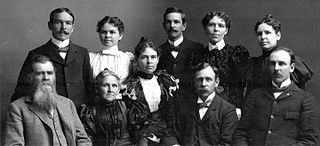
Joseph James Blick, sometimes credited as Joseph J. Blick, was an American architect who worked on commercial and residential projects and is best known for diverse residences in Southern California ranging from Mission to Modern styles. Born and raised in Clinton, Iowa, his father James Shannon Blick was a building contractor. The Blick family moved to Pasadena, California in 1887 soon after his sister Blanche married Frederick Russell Burnham, the celebrated scout and long time resident of California. Blick began working in Pasadena as a contractor with his father and in 1889 he apprenticed with T. William Parkes, a member of the Royal Institute of British Architects. In 1891, he married Daisy Russell, a first cousin of Frederick Russell Burnham. After completing his apprenticeship, Blick and Lester S. Moore founded their own architecture firm, Blick & Moore, in Los Angeles in 1895, where he continued to work until his retirement in 1937. Several of his commercial buildings and residences have been listed with the National Register of Historic Places.

The Florence Robinson Cottage, also known as the Florence Robinson Building and the Alumni Heritage House, is a structure on the National Register of Historic Places located in Wood County, Texas on the campus of Jarvis Christian College outside Hawkins, Texas. The cottage is in the Modern Movement Style.

The Woodlea Historic District is located in central Phoenix, Arizona, United States. The neighborhood runs from Glenrosa Ave. south to Monterosa St. and from Seventh Ave. west to Fifteenth Ave. The neighborhood as well as many of the individual houses are listed on the National Register of Historic Places. The neighborhood is known for its tree shaded sidewalks, abundant plant life and is served by an antique irrigation system from the Grand Canal.
Milliron's Westchester, later The Broadway-Westchester, was a department store at 8739 S. Sepulveda Blvd., in Westchester, Los Angeles, designed by architect Victor Gruen. Its original design was considered a landmark in exterior architecture of retail stores, although much of the original design is no longer present. The building now houses a Kohl's.

The Williams House is a historic single-family residence located at 5 Williams Road in New Fairfield, Connecticut. Likely built between 1800 and 1835, it is a well-preserved example of early American residential architecture, with transitional Federal and Greek Revival features. The house was listed on the National Register of Historic Places in 2014.
Sidney Preston Dones was an American businessman involved in real estate, insurance, legal services, and the film business.
References
- 1 2 3 "City of Palm Springs Citywide Historic Context Statement & Survey Findings". www.palmspringsca.gov. Retrieved 2021-01-29.
- ↑ "NHRP registration form". www.nps.gov. Retrieved 2021-01-29.
- ↑ "NHRP registration form". www.nps.gov. Retrieved 2021-01-29.
- ↑ "M E M O R A N D U M" (PDF). Retrieved 2021-01-29.
- ↑ "NHRP registration form". www.nps.gov. Retrieved 2021-01-29.
- ↑ "NHRP registration form". www.nps.gov. Retrieved 2021-01-29.
- ↑ "NHRP registration form". www.nps.gov. Retrieved 2021-01-29.
- ↑ "NHRP registration form". www.nps.gov. Retrieved 2021-01-29.
- ↑ "NHRP registration form". www.nps.gov. Retrieved 2021-01-29.
- ↑ "NHRP registration form". www.nps.gov. Retrieved 2021-01-29.
- ↑ "NHRP registration form" (PDF). www.nps.gov. Retrieved 2021-01-29.
- ↑ "Southwestern Bell Capitol Main Office". www.nps.gov.
- ↑ "NHRP registration form". www.nps.gov. Retrieved 2021-01-29.
- ↑ "NHRP registration form" (PDF). www.nps.gov. Retrieved 2021-01-29.